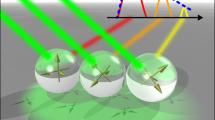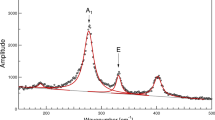Abstract
DR STEEDS REPLIES: Dr Goodman1 casts doubt on the bright field rotation method2 of identifying the presence of faults parallel to the surface of a specimen. The examples quoted in support of his point of view are, however, inadequate. Whereas our experiments are often performed over rotations of 20° or more, in the convergent beam work in gold, cited by Dr. Goodman, the angular range in view is 1.29° at 4.21° from [111], which is much too limited for a test. During large rotations the systematics-only pattern is interrupted by various non-systematic reflections, but there are several ranges of orientation in which non-systematics are not important and the asymmetric pattern returns to essentially the same form. The graphite example is irrelevant because the field of view is restricted to a narrow angular range close to the [0001] zone axis where the pattern is dominated by rapidly varying cross-grating contributions; our ‘rule’ refers to contours which result essentially from one-dimensional diffraction. Clearly, the misunderstanding arises from the very great difference of angular view in convergent beam and bend contour patterns, despite their formal equivalence (to a first approximation). Effects of inclination, although important for really large tilts, such as the 54° from the normal of the foil used by Dr Goodman, are not in our experience significant for smaller rotations of the order which we propose in our experimental test, at least not for bend contour patterns, where a certain amount of distortion is almost inevitable.
This is a preview of subscription content, access via your institution
Access options
Subscribe to this journal
Receive 51 print issues and online access
$199.00 per year
only $3.90 per issue
Buy this article
- Purchase on Springer Link
- Instant access to full article PDF
Prices may be subject to local taxes which are calculated during checkout
Similar content being viewed by others
References
Goodman, P., Nature, 251, 700–702 (1974).
Tatlock, G. J., and Steeds, J. W., Nature phys. Sci., 246, 126 (1973).
Hirsch, P. B., Howie, A., Nicholson, R. B., Pashley, D. W., and Whelan, M. J., Electron Microscopy of Thin Crystals (Butterworths, London, 1965).
Bunn, C. W., Chemical Crystallography (Clarendon Press, Oxford, 1945).
Author information
Authors and Affiliations
Rights and permissions
About this article
Cite this article
STEEDS Role of upper-layer interactions in electron diffraction symmetries (reply). Nature 251, 701–702 (1974). https://doi.org/10.1038/251701a0
Received:
Issue Date:
DOI: https://doi.org/10.1038/251701a0
This article is cited by
-
Further note on electron diffraction symmetries
Nature (1975)
Comments
By submitting a comment you agree to abide by our Terms and Community Guidelines. If you find something abusive or that does not comply with our terms or guidelines please flag it as inappropriate.



